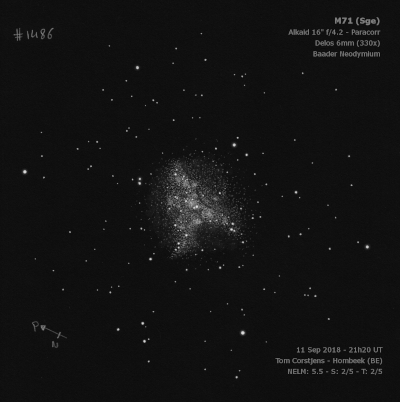
15x50mm IS binoculars (6/19/09): bright, obvious glow is elongated with a brighter center.
Philippe de Chéseaux discovered M71 = NGC 6838 = h2056 in 1745-46. Johann Koehler independently rediscovered it between 1772 and 1779 with a 6-foot Dollond telescope at only 30x and noted "a very pale nebulous patch in the Arrow [Sagitta]." Pierre Méchain found it again on 28 Jun 1780 and he is credited with the discovery in the NGC.
WH first observed the cluster on 30 May 1783 using his 8-inch (10-ft focal length) and noted it was "resolved into stars. I can count between 20 and 30 of them." He viewed it several times in his larger scopes and logged "a very compressed cl of stars." on 18 Aug 1784 (sweep 252) and "a cl. of stars; the stars pretty large, nf is a part seemingly separated" on 18 Sep 1784 (sweep 276). JH recorded on sweep 90, "vL; loose; fills field; a fine object; stars 11...16m; the most condensed part = 3', of an acute triangular figure, the angle northwards."
200/250mm - 8" (10/4/80): many faint stars were resolved with averted. The west edge is brighter.
300/350mm - 13.1" (7/16/82 and 8/22/87): a few dozen stars are resolved over haze, only weakly concentrated, non-symmetrical shape. Impression that many faint field stars may be superimposed. Located in a very rich star field.
400/500mm - 17.5" (8/5/94): roughly 75 stars resolved in a 5' diameter but has a very irregular ill-defined outline to the halo. The brightest section is elongated SSW-NNE with dimensions 3'x2'. The brightest star is on the east side of the core and is a close double. Located in a rich field with likely many field stars superimposed around the halo. Located just south of the midpoint between Gamma and Delta Sagittae.
Harvard 20, less than 30' SSW, contains about three dozen stars in a 6'x3' field, elongated ~E-W. Two bright mag 9 stars are off the west side but the cluster is dominated by 20 mag 12/13 stars. Also includes a scattering of faint mag 14-15 stars. A pretty evenly matched mag 12.5/12.5 double star is at the east end and an uneven mag 12/14 double star is to the west of the well matched double.
600/800mm - 24" (9/2/16): at 200x and 375x; beautifully rich cluster mostly defined by an intense triangular central or core region with vertices on the north, southwest and southeast corners and sides ~3', 3' and 2.3'. Roughly 100 stars are densely packed over the background glow within this triangular outline, though the north end is less well defined. The surface brightness falls off rapidly outside this core, though the halo includes some brighter stars, and the cluster blends into the fairly rich field density beyond a diameter of 5'. Open cluster Harvard 20 lies 28' SSW.
Notes by Steve Gottlieb